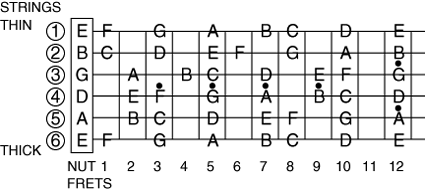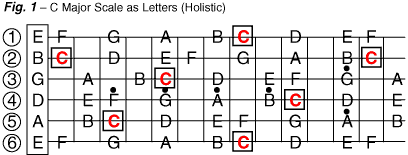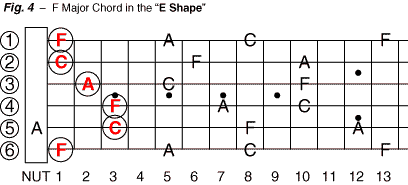|
Guitar EncycloMedia is Total Fretboard Knowledge In One Book!
|
Discover Why Guitarists Everywhere Are Raving About This Amazing Book That Enables You To Finally Understand The Guitar Fretboard.
Yes, you're a guitar player, but you're more than just a guitar player, you're a musician, thinking and speaking the
language of music that you then apply to the guitar, thus becoming a student of the guitar.
Guitar EncycloMedia is based on the premise that music is a language.
If you knew the music alphabet of 12 Sounds and 21 Symbolic letters and tone numbers on your guitar, you could spell any chord,
scale, or arpeggio, and then combine them to play any song in any style.
So, where does music begin? Like most languages, with an alphabet. Now, you've known the English alphabet of 26 letters
most of your life, but, do you know all the words in the dictionary? We know the answer to that question. However, do you know
every letter in the dictionary? Yes! So the question becomes, if you know every letter in the dictionary, why
don't you know every word? The answer, because you don't know how to
spell them.
On your first day of school they didn't give you a book of Shakespeare and a dictionary and say Go home you're finished.
You understand that's absurd. However, that's what you're trying to do with the guitar.
You say, I want to play this song. Then you open a song book, see the first chord, find it in your chord dictionary,
try to finger it and then move on to the next chord. You will never learn guitar that way.
Remember the first grade? You memorized a list of vocabulary words that you could spell. This enabled you to read a story that
contained those words. Then you learned a new list of words, read a new story, a new list, a new story, and so on. Until finally,
years later, you could read that book of Shakespeare.
This is how you must understand the language of music. As a vocabulary of chords, arpeggios, scales and modes that you can spell and play.
Pythagoras told us that if we take a string length and divide the string in half the frequency is doubled
and the octave is created. So from the nut to the bridge is one
string length and fret 12 divides the string in half. Now, you
have 12 frets, one for each of the 12 pitches, letters and tone numbers.
While it's true there are 12 pitches in music, there are only 7 letters in the music alphabet: A, B, C, D, E, F, G. These 7 letters are placed horizontally on every string.

Most guitarists start with a vertical view of the fretboard. However, by not seeing the the horizontal view, they miss the concept of chord shapes which are vertical groupings of the horizontal letters and tones.
Trying to remember thousands of chord block diagrams, vertical groupings, by memorizing finger patterns will never work.
You learn and remember chords, arpeggios, scales and modes by spelling them!
Going a step further, the letters of the C Major scale: C, D, E, F, G, A, B can be thought of as tone numbers or scale degrees. So instead of "Do-Re-Mi", which in the key of C major is C, D, E, we can give those letters tone numbers: 1, 2, 3. Now you can spell in tone numbers as well as in letters.
This is very important because we have two ways to think about the guitar as letters and those letters as tones, in any given key. Okay, we now understand that music is a language which is expressed as an alphabet of letters and tone numbers.
This is the most important idea for Turning A Guitar Player Into A Dynamic Musician!
Now, getting back to our first analogy, we learned that if you knew all the letters of the alphabet it would be possible to spell all the words in the dictionary. In the same way, if you knew the musical alphabet of 7 letters on the guitar fretboard, you could spell all songs!
Do you know the song Happy Birthday? Yes? Okay, can you play it? No, why? Because you don't know how to spell it. That's the concept.
If you know how to spell it you can play it. In fact, you can play anything you know how to spell!
Guitar EncycloMedia teaches you how to see the guitar in a very simple way, as letters and tone numbers on the fretboard, which enables you to play anything you can spell.

The question now becomes, what do you know how to spell? How big is your vocabulary? Remember, no matter what song you want to play, if you have the vocabulary you'll be able to play that song.
However, you must have an order, a system, a method to get through the complex vocabulary of the guitar. And Guitar EncycloMedia introduces this vocabulary in the proper sequence.
As you can see in the above diagram, Guitar EncycloMedia, doesn't use staff notation to represent music, or tab to show its application on the guitar. Instead, fretboard diagrams and an alpha-numeric, letters and tone number, system of spelling is used to develop a vocabulary which will make it possible for you to read and perform any song in any style.
As a general statement, Guitar EncycloMedia presents its material in four parts: chord, scale, arpeggio, song. In traditional music theory, an "in order" scale is first presented, and then from the letters and tone numbers of that scale, chords and arpeggios are spelled (constructed). However, I've chosen to introduce chords first because we tend to hear the harmony, chords, of a song first, and then play an "out of order" scale melody that fits the chords.
In Guitar EncycloMedia you will discover five moveable barre chord forms. As was said earlier, these five moveable forms are created by vertically grouping the letters and tones of a chord in one position. However, there are thousands of chord fragments on the guitar, and these should also be explored.
In addition, seven forms of vertically grouped scales and arpeggios are presented, and once again there are thousands upon thousands of fragmented possibilities.
By studing and applying Guitar EncycloMedia, you will also discover there are many innovative ways to reveal the hidden secrets of your fretboard such as the 5 Hidden Chord Forms seen below.

There are 42 songs included in Guitar EncycloMedia, and every song has been analyzed to show each chord's corresponding tonal center scale and mode, providing you with many opportunities to apply the chords, scales and arpeggios as you learn them. Also, numerous substitution ideas are presented, which suggest endless variations.
Guitar EncycloMedia Is The most complete reference of Guitar knowledge Available
Containing 323 Pages of Chords, Arpeggios, Scales and Modes Needed To Perform Any Song In Any Style.
Guitar EncycloMedia has a table of contents and an index so that locating any chord, arpeggio, scale or mode fast and easy!
Here Are A Few More Important Ideas You will Discover in Guitar EncycloMedia:
Letter
and Tone Fretboard Charts
Open Major Chords
Five Major Chord Forms
Diatonic and Chromatic Intervals
Nine Triads
Chord and Arpeggio Spelling Chart
Key Signatures
Major Scale Letter Chart
One Fret Rule
Seven Scale and Arpeggio Forms
Octaves Chart
Major Scale Harmony
Circle of Fifths
Major Scale Modes
Alterations and Extensions
Minor Chords
Natural Minor Scale and Progressions
Minor Pentatonic Scale
Power Chords
TAB and Staff Notation
Major Pentatonic Scale
Chord Substitutions |
Blues Scale and Harmony
12 Bar Blues Progressions
Major Scale Tonal Center
ii-V-I Progression
Augmented, Suspended and Diminished Triads
Whole Tone Scales
Inversions
Slash Chords and Progressions
Melodic Minor Scale and Modes
Dominant Seventh Altered
Flat-Five Substitution
Harmonic Minor Scale and Modes
Diminished Scale Construction
Major and Minor Turnarounds
Chord and Arpeggio Construction
Scale and Mode Tone Spellings
Cross-Correlations
Enharmonic Chords
Polychords
Overlapping Chords and Arpeggios
Chord-Arpeggio-Scale/Mode Relations
and Much More... |
100% Money-Back Guarantee!
We want your playing to improve! So, if you're not completely satisfied with your Guitar EncycloMedia, return it to us and we'll give you a complete refund.
It's as simple as that... No Risk!
|